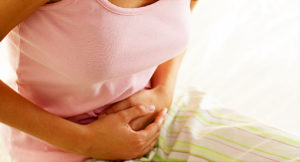What is endometriosis?
Endometriosis is a chronic inflammatory condition that affects up to 1 in 10 women of reproductive age, and typically causes pelvic pain, painful periods and reduced fertility. In clinical terms, endometriosis means the growth of endometrial tissue (i.e. internal lining of the uterus or womb) outside the uterus. This can occur anywhere in the pelvis, most commonly behind the uterus, on the ovaries or in front of the uterus, and very rarely in regions distant from the pelvis, such as the lungs. Just like the endometrial lining of the uterus, these endometriosis lesions also release blood and inflammatory factors into the pelvis during menstruation. Over time, this can cause scarring, cysts and adhesions in some women, increasing pain around periods and even throughout the menstrual cycle. The presence of endometriosis can only be confirmed by laparoscopic (keyhole) surgery. Depending on the amount, location and type of endometriosis lesions observed by the clinician during laparoscopy, the disease is graded as minimal (Stage I), mild (stage II), moderate (stage III) and severe (Stage IV).
What causes endometriosis?
Despite being recognized since the 1800s, its high prevalence in the global female population and the significant economic and medical impacts it imposes, the exact cause of endometriosis remains poorly understood. The leading theory is that of ‘retrograde menstruation’, i.e. that during menstruation, blood can reflux back through the Fallopian tubes and into the pelvis, carrying small fragments of endometrial lining. It is thought that these fragments can either implant and themselves cause endometriosis, or stimulate the lining of the pelvis to develop into endometriosis. In support of a role for retrograde menstrual bleeding, it is very unusual for endometriosis to occur in women who are not menstruating, and it is more common in women who have long, heavy and frequent periods. However, retrograde menstruation is estimated to occur in up to 90% of women, while only 10% of women will develop endometriosis, so this is clearly not the whole story. We know that there is a genetic predisposition for endometriosis, particularly the severe forms of the disease. Women who have a first-degree relative (i.e. mother or sister) with endometriosis are six times more likely to develop it themselves, but as yet there is no genetic test to determine endometriosis risk. No major differences have been found in the actual menstrual blood of women with or without endometriosis, but a number of studies have shown distinct changes in the endometrial lining of the uterus itself. Differences have also been found in the pelvic fluid of women with endometriosis, but whether these changes are a cause or result of the disease remains unknown.
How does endometriosis affect fertility?
Endometriosis is a leading cause of reduced fertility in women, occurring in 30-50% of women attending fertility clinics for assisted reproduction. However, up to two-thirds of women with endometriosis will have no difficulty conceiving, and it is not yet clear what distinguishes those women who will struggle from those who will not. In severe endometriosis, distortion of the ovaries and Fallopian tubes can impede fertilization and pregnancy establishment, while ovarian cysts (called endometriomas or chocolate cysts) can interfere with ovulation and the ability of the ovary to produce good quality eggs. In milder grades of endometriosis, where the pelvis is not significantly distorted, the reasons for subfertility are less obvious. Many studies have indicated that the immune system of women with endometriosis-associated infertility may be different to that of healthy fertile women. For instance, studies have revealed increased inflammatory factors in the fluid of the peritoneal cavity and in the endometrium of women with endometriosis, which are likely to impact ovulation, egg development and embryo implantation. Research from Merrion Fertility Clinic, in collaboration with Trinity College Dublin, found differences in uterine immune cells in women with endometriosis-associated infertility who had a successful cycle of IVF compared to women who were unsuccessful. While there is compelling research evidence of immune dysfunction, it is important to note that, as yet, there are no immune tests or treatments that are of value. Neither is there any international consensus on the cause or mechanism of subfertility in endometriosis.
What are the options to treat infertility in endometriosis?
For women with endometriosis who are trying to conceive, it is generally recommended that they seek help after 6 months of trying. If a woman is unsuccessful after a year of trying, it is very likely that she will need assistance to conceive. The two main options are surgery or assisted reproduction, most commonly IVF. For women with mild forms of endometriosis, there is evidence that surgical removal or destruction of the lesions can improve fertility, possibly by reducing pelvic inflammation. Surgery has also been shown to improve fertility in severe endometriosis. If the pelvis is restored to a near normal state, around 30-50% of women will conceive in the 12 months following surgery. For this reason, for young women with no other significant infertility factors (e.g. partner’s sperm quality), laparoscopic surgery is typically the first option. In women over 35, the benefits of surgery as opposed to proceeding directly to assisted reproduction need to be carefully weighed. IUI is a viable option only for women with mild disease (Stages I and II), but not for those with significant scarring or inflammation. IVF is a very effective treatment for the majority of women with endometriosis. For young women with severe endometriosis, who are not yet in a position to conceive and may require major surgery and/or removal of an ovary, egg freezing (oocyte vitrification) should be considered as an option to preserve their future fertility.
For further reading, please see:
The Fertility Handbook (Gill Press), Professor Mary Wingfield
https://merrionfertility.ie/patient-information/causes-of-female-infertility/endometriosis/
